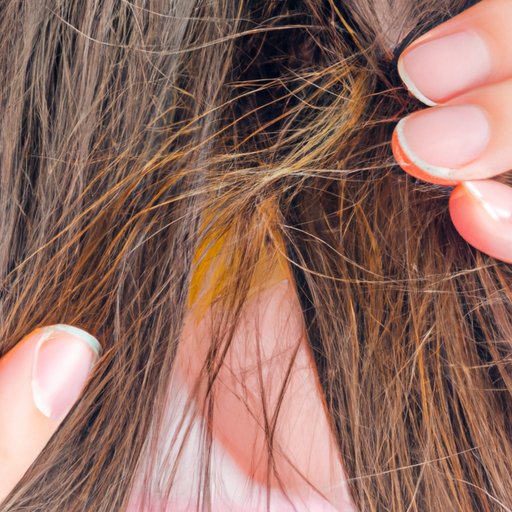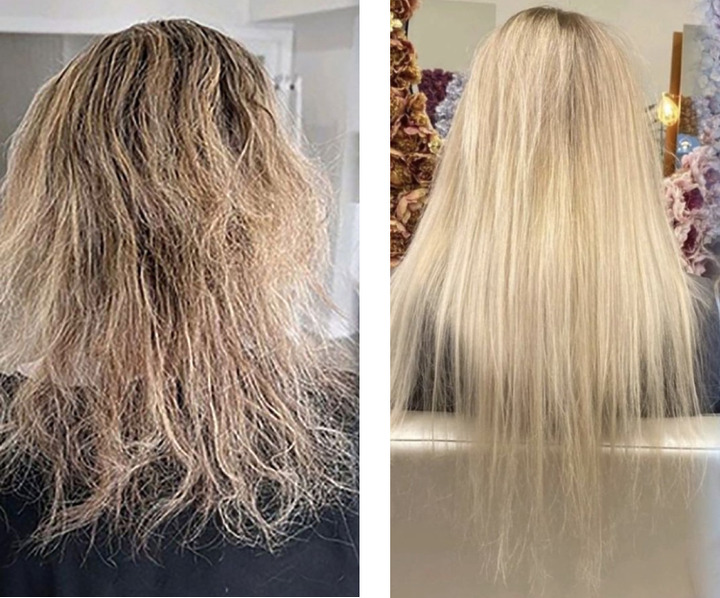Is your hair looking less than its best? Understanding the signs of hair breakage is the first step toward restoring your locks to their former glory and preventing further damage.
The quest for healthy, vibrant hair often leads us down a path of product trials, styling experiments, and a constant awareness of our hair's condition. But amidst this, a common enemy often emerges: hair breakage. It can strike without warning, leaving us with a less-than-ideal appearance and a feeling of frustration. But what exactly does hair breakage look like? And more importantly, how can we combat it?
| Feature | Details |
|---|---|
| Definition | Hair breakage refers to the snapping or splitting of hair strands, resulting in shorter, uneven lengths. |
| Appearance | Characterized by short, spiky hairs with split or damaged ends; broken hairs may stick up, have a rough/frizzy texture. |
| Common Symptoms | Frizzy, dull hair; white spots on strands; ragged or thinning ends; uneven hair lengths. |
| Causes | Stress, heat styling, chemical treatments, underlying health conditions, and mechanical damage. |
| Normal Shedding vs. Breakage | Normal shed hairs are usually the length of your hair, with a tiny white bulb at the root; breakage presents as shorter, irregular fragments. |
| Distinguishing from Baby Hair | Baby hair is typically fine and wispy, growing from the scalp; breakage is often damaged and split. |
One of the most tell-tale signs of hair breakage is the appearance of short, spiky hairs. These aren't the smooth, flowing strands we desire; instead, they're often characterized by split or damaged ends, giving them a rough, uneven texture. They may stick up and away from the scalp, disrupting the overall smoothness of your hairstyle. This contrasts sharply with healthy hair, which appears sleek and shiny, reflecting light and moving gracefully.
- Martin Rivers Biography Movies Music Net Worth More Discover Now
- Cj Jacks Gay Porn Hot Videos Exclusive Scenes
But what exactly are the visual cues to look for? "Frizzy, dull hairs" that appear in your hairbrush or comb after brushing are a clear indicator. These hairs are often damaged, and the friction of brushing can exacerbate the breakage. White spots on individual hairs, easier to spot on darker hair colors, can also be a warning sign. These spots, often the result of damage to the hair shaft, indicate areas where the hair is weakened and susceptible to breakage. Ragged, thinning ends are another common symptom, as are strands that appear to be different lengths on either side of your head. This unevenness is a direct result of hair snapping off at various points along the shaft.
It's also important to differentiate between hair breakage and other hair conditions. Flyaways and smaller pieces of hair aren't always a sign of damage. Instead, they might just be "baby hairs" or new growth that hasn't yet developed the same length and weight as your existing hair. These baby hairs are typically fine and wispy, growing from the scalp, in contrast with breakage, which is often characterized by damaged and split ends.
Now, let's move beyond the symptoms and delve into the potential causes of hair breakage. This is important because understanding the underlying reasons is critical for finding effective solutions. Hair breakage can stem from a variety of factors, ranging from lifestyle choices to underlying health conditions.
- Exploring The Pledge Insights Details You Need To Know
- Discovering Payton James From Hair Styling To Handbags More
One major contributor is stress. Our bodies respond to stress in various ways, and the impact on our hair can be significant. Prolonged periods of stress can disrupt the hair growth cycle, leading to weaker hair that is more prone to breakage. Hormonal imbalances, often linked to stress, can further exacerbate the problem. Stress can trigger hair loss in some cases, where hair falls out at the root, leading to thin patches or overall hair thinning.
Heat styling is another common culprit. The use of heat-based tools like hair dryers, curling irons, and straighteners can cause significant damage to the hair shaft. Repeated exposure to high temperatures strips the hair of its natural moisture, leaving it dry, brittle, and vulnerable to breakage. The damage caused by heat styling is often cumulative, meaning that the more frequently you use these tools, the greater the risk of hair breakage.
Chemical treatments, such as perms, relaxers, and coloring, can also be detrimental to hair health. These treatments involve harsh chemicals that can alter the structure of the hair, leading to dryness, weakening, and, ultimately, breakage. Over-processing, or the repeated application of these treatments, can compound the damage, increasing the likelihood of severe hair damage.
Underlying medical conditions can also play a role. Certain medical conditions can impact the health of your hair, including thyroid disorders, nutritional deficiencies, and autoimmune diseases. These conditions can interfere with the body's ability to produce healthy hair, making it more susceptible to breakage and hair loss.
Mechanical damage, such as aggressive brushing, tight hairstyles, and rough handling of the hair, is yet another common cause. Brushing hair too roughly, especially when it is wet, can cause friction and breakage. Tight hairstyles, such as tight ponytails, braids, and buns, can pull on the hair, weakening the strands and contributing to breakage. Even the simple act of rubbing your hair vigorously with a towel after washing can cause friction and lead to damage.
So, what can be done to address hair breakage? Fortunately, there are several steps you can take to promote healthier hair and minimize breakage.
First and foremost, protect your hair from heat. If you frequently use heat styling tools, consider reducing their use or adjusting the heat settings to the lowest effective temperature. Always use a heat protectant spray before applying heat to your hair. This creates a barrier between the hair and the heat source, helping to reduce damage. If possible, let your hair air dry, especially after washing.
Next, handle your hair gently. Use a wide-tooth comb to detangle wet hair, starting from the ends and working your way up to the roots. Avoid tight hairstyles that pull on the hair. When brushing, use a soft-bristled brush and avoid brushing your hair too vigorously. Be mindful of the materials your hair comes into contact with, and opt for silk or satin pillowcases, which can reduce friction and breakage while you sleep.
Nourish your hair from the inside out. A balanced diet rich in essential nutrients is crucial for healthy hair growth. Ensure you are getting enough protein, vitamins, and minerals to support hair health. Consider incorporating supplements like biotin, zinc, and iron, if recommended by a healthcare professional, as deficiencies can affect hair health.
Incorporate deep conditioning treatments into your routine. Regular deep conditioning can help to replenish moisture and strengthen the hair shaft. Choose products specifically designed for damaged hair, looking for ingredients like keratin, protein, and natural oils. Apply the deep conditioner to your hair after shampooing and leave it on for the recommended time. You might choose to use a heat cap to enhance absorption.
Consider visiting a professional. A hair stylist can assess the condition of your hair and recommend appropriate treatments and products. They can also provide personalized advice on how to care for your hair and prevent future damage. They can help you identify specific causes of breakage and create a tailored plan to address them.
Minimize chemical treatments. If possible, reduce the frequency of chemical treatments like coloring, perms, and relaxers. If you do choose to have these treatments, seek out experienced professionals who use gentle techniques and high-quality products. It's also crucial to space out your treatments and allow your hair time to recover between each one.
Hair breakage is a multifaceted issue with a range of causes and a variety of solutions. It is not always easy to pinpoint the exact cause, but with a bit of detective work and the right approach, it is possible to combat hair breakage and restore your hair to a healthy state. By recognizing the signs, understanding the causes, and adopting the correct care practices, you can prevent further damage and enjoy stronger, more resilient hair.
Remember, consistent, and targeted care is key. The sooner you take action, the better your chances of reversing damage and achieving the healthy, vibrant hair you desire.
- Devlan Encryption Secure Tools Insights Learn More
- Brad Coleman News Profiles Amp Updates Latest Insights


